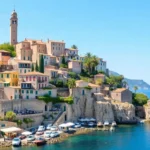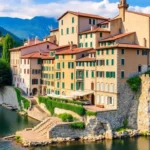Visiting the Archaeological Park of Neapolis in Syracuse

If you're planning a trip to Sicily, the archaeological park of Neapolis in Syracuse is an absolute must-visit. In this guide, we'll take you through the essential details of exploring this historical gem, offering tips, insights, and a recommended walking route to enhance your experience.
Sicily is a melting pot of cultures and history, with numerous civilizations having left their mark on the island. Among them, the Greeks and Romans stand out for their monumental contributions. They established cities rich in culture and prosperity, and today, visitors can marvel at the impressive ruins that remain.
One of the most significant sites to explore is the Neapolis Archaeological Park in Syracuse. This park is not only home to stunning ruins but also serves as a testament to the island’s rich historical tapestry. Below, we provide key information for your visit, including highlights and practical tips to make the most of your time.
What to see in the Neapolis of Syracuse
The Neapolis Archaeological Park is situated on a hillside, northwest of the urban area of Syracuse. This location corresponds to the ancient city of Syracuse, where early civilizations made their home. Within the park, you will find various ruins that offer a glimpse into the past. Here are some of the main attractions:
1. Roman Amphitheater
This impressive structure was partially excavated from the local rock and boasts substantial dimensions. Visitors can explore one of its tiered walkways and observe two main entrances.
The sandy arena reveals an intricate system of underground passages and rooms where gladiators and wild animals awaited their turn to entertain the crowds. The well-preserved ruins provide a vivid reminder of the spectacles that captivated audiences in the ancient Roman Empire.
2. Altar of Hierón (Ara di Ierone)
Although only the base remains, the sheer size of the altar is striking: 198 meters long and 23 meters wide. This monumental site was where sacrifices occurred, reflecting the significance of such rituals in classical times.
It is said that up to 450 bulls were sacrificed here to celebrate a military victory, showcasing the grandeur of these ancient ceremonies.
3. Greek Theatre
Originally constructed by the Greeks and later enhanced by the Romans, the Greek Theatre is arguably the most important ruin in the entire park. While the Romans favored bloody spectacles, the Greeks appreciated the arts, which is why numerous significant plays were staged in this venue.
During the spring and summer months, visitors might be lucky enough to catch a performance, allowing them to immerse themselves in the cultural experience of ancient Greece.
4. Dionysius's Ear
This cave, carved into the rock by slaves, served both as a quarry and a prison. Legend has it that Dionysius would use this space to eavesdrop on prisoners, thanks to its remarkable acoustic properties that allowed whispers to be heard from outside.
During our visit, we encountered a choir that spontaneously sang within the cave, creating a truly magical moment!
5. Latomia del Paradiso
This stone quarry houses the Ear of Dionysius and is now blanketed in lush vegetation. In its center stands a monolith that indicates the original size of the rock before it was excavated. Visitors must traverse this area to continue their journey through the park.
6. Necropolis of Grotticelle and Tomb of Archimedes
Located in the northernmost part of the park, the Necropolis consists of small rock-cut caves used during the Greco-Roman era for burials. While one cave is famously referred to as the Tomb of Archimedes, the actual burial site of this renowned philosopher remains a mystery.
How to get to the Neapolis of Syracuse
The Neapolis Archaeological Park is conveniently located in the urban area of Syracuse, near the striking yet unremarkable Santuario della Madonna delle Lacrime. Depending on where you are staying, you can easily walk to the park. Although it’s a bit farther from the Ortigia area, it is still manageable on foot.
If you're driving, you can park for free along Viale Augusto. Keep in mind that you might encounter individuals asking for tips in this area.
Ticket Information
There are two ticket offices where you can purchase entrance tickets. One is located in the shopping area where buses park (on the corner of Viale Augusto and Via Francesco Saverio Cavallari), which is often designated for groups. However, we bought our tickets there without issue. The second office is at the park entrance itself.
We recommend the latter for its multilingual maps and the option to rent an audio guide. Alternatively, you can buy tickets online through the official website, where they typically cost €13. If you prefer a guided experience, consider booking a guided tour of the Neapolis Archaeological Park.
How to explore the Neapolis of Syracuse
Upon entering the park, we suggest following this recommended route:
- First, turn left after passing the ticket office to visit the Roman Amphitheater. Walk along the grandstand on one side and take in the view before returning to the ticket office.
- Just 20 meters away, to your left, you'll see the Altar of Hieron. Although it’s behind a fence and can only be viewed from the path, the grandeur of the altar is still impressive.
- Continue to a new area where you’ll pass through a ticket check before reaching a fork. Visit the Greek Theatre first. We recommend approaching from the left to view it from below, then ascend to explore the seating area and enjoy the vista from the top terrace, where you can find the Grotta del Ninfeo, a small cave with a fountain.
- Return to the fork and head down towards the Latomia del Paradiso. Stroll leisurely beneath the shade of the trees as you take in the sights.
- As you explore, you'll come across the striking entrance to the Dionysius's Ear, truly one of the most astonishing sites during your Sicilian adventure!
- Finally, follow the path back to the starting point to conclude your visit, although if time permits, you can venture north to explore the Grotticelle and the Tomb of Archimedes.
Duration and Tips for Visiting the Neapolis Park
A complete tour (excluding the northern section) typically takes about an hour and a half. If you opt for a guided tour and enjoy lingering at each site, you can expect to spend more time.
The visit is relatively easy, with most attractions situated close together. However, if you're visiting during the hot summer months, it's wise to avoid midday sun, stay hydrated, and apply sunscreen.
Is it worth visiting the Neapolis of Syracuse?
Admission to the Neapolis of Syracuse costs €13. In our opinion, the experience is well worth it. It stands out as one of the most remarkable classical ruins we've encountered, not just for the state of preservation or size, but for the variety of unique sites that each possess their own charm.
Map of the visit to the Neapolis of Syracuse
Here’s a map highlighting the must-see points and recommended route within the park. We hope it proves helpful!
As you can see, the Neapolis of Syracuse is one of the most captivating places in all of Sicily. It’s an unmissable destination for anyone traveling through this beautiful Italian island.
Discover more about Syracuse and its enchanting sights through the video linked above, which showcases the beauty and history of this remarkable city.
| Ahorra en tu viaje |
| Compara y consigue vuelos baratos aquí |
| Encuentra alojamiento a los mejores precios aquí |
| Reserva actividades y excursiones en español aquí |
| 5% de descuento en tu seguro de viaje IATI aquí |
| Reserva los traslados desde el aeropuerto aquí |
| Regalo de 10€ reservando el transporte por Europa aquí |
| Averigua cómo sacar dinero sin comisiones aquí |
| Descuento del 5% en tu eSIM de Holafly aquí |
| Alquila un coche con las mejores ofertas aquí |
| Compara precios del alquiler de furgonetas aquí |
| Los mejores libros y guías de viaje aquí |
| Todos nuestros artículos sobre Italia |




Deja una respuesta